Indian magazines flex their muscles: Conde Nast, Delhi Press, Haymarket Publications, Infomedia 18, Next Gen, Spenta Multimedia
Leading publishers tell Tanvi Parekh about their key challenges and explain their plans for expansion, dealing with new platforms and solving the distribution issue
12 Jul 2011 | By PrintWeek India
Oona Dhabhar,
Conde Nast India
We publish three titles in India. Architectural Digest is scheduled to launch in March 2012. In addition, our digital unit Condé Nast Digital was launched in June 2010. There have been a number of new titles in the lifestyle space over the last 12 months. As the affluent Indian continues to evolve and develop interests and hobbies, there is an opportunity to launch special interest titles.
We outsource our printing to Manipal Press who deliver the desired Condé Nast quality. Condé Nast India (CNI) is the only 100 percent subsidiary of Condé Nast International. All other international titles present are licensed. This allows us to invest in editorial, production and marketing and deliver a world-class magazine product.
There is tremendous opportunity in both print and online media as we have seen with the growth in our numbers. Magazine readership for both Vogue and GQ has seen double-digit growth and at the same time all our digital offerings are also witnessing significant growth.
Our philosophy at Condé Nast India has been to create a multimedia platform to reach the affluent and leverage the opportunities across print platforms and online. Paying for content has increasingly become more acceptable to the digital consumer, especially with the advent of mobile and tablet applications. Content provided in the right format and context will be able to command a value from the consumer.
Magazine distribution in India is at a nascent stage, large part of the sales continues to come from small newsstands. However, chain book stores continue to co-exist with conventional newsstand.
CNI revolutionised the magazine distribution business with the launch of Vogue by investing in visibility and building relationships with the chain and airport book-stores. This has become the industry norm in India. While we distribute through Living Media Group (distribution arm of the India Today group) to ensure a pan-India reach, we monitor and track sales through dedicated resources. We invest across channels, be it modern trade, airports or news stands.
We do not follow a prescribed ratio of content to advertising. We believe the quality of advertising in our magazines blends seamlessly with our content. Therefore there is no disconnect between features and content.
Divesh Nath,
Delhi Press
We publish 31 magazines in nine languages. More than 3.5 million magazine copies per month are printed in our own printing presses. Caravan, our recent launch (now incorporated in the monthly publication, Alive), was the first publication of Delhi Press by my grandfather Shri Vishwanath in 1938. It was followed by the launch of Sarita in 1945. We have three printing plants in the NCR region. In-house printing facilitates flexibililty.
Funding operations for media is always an issue. Large corporates prefer the IPO route. The most common operation is a JV and an equity stake sale. However, the structuring valuation of a media company is very complex. On one side, you have the high PE business of media and on the other there is the PE for printing services. Since most publishing houses own real estate properties, there is complexity to the valuation, which most of the old and established media companies have.
Both print and online versions of the same title are necessary. Some European publications have dispensed with the print version of the magazines. The South Asian economies have a long way to go, subject to the regional disparity and language issues and most importantly, the love for print. In my opinion, the print and the online version are independent of each other. The readers for each of them are unique. I can’t imagine a print version of Google, Facebook, Twitter or Linkedin.
Jobs advertising will have to go to the internet since it’s an instant media and people want instant results in their career. Companies need instant staffing. Besides, the complexity of travel, cell phones have taken people away from the newspaper pages. Some of the job sites are effective.
Magazine distribution market in India is very expensive with the prices of transport being high. Plus the post office is not as reliable as it used to be.

Gilbert D’souza,
Haymarket Publications (India)
There are huge changes in the magazine market. This is true in the publishing segment. We feel this is a necessary, albeit painful change, that will ensure the long-term future of the industry. Prices will increase over time, but in the short term this will affect those publishers that have shifted work regularly in order to gain sub-market prices and suppliers that have offered unsustainable price models.
We are aware of the price pressures on our suppliers and we will continue to work with them to look at efficiencies in the supply chain that can benefit us both. Haymarket has done this with great success with our titles by rationalising print sizes, paper weight and stock.
Investments in the magazine space has enabled shorter-run magazines for a niche market. At Haymarket, we see this with Campaign India and PrintWeek India.The rising cost of retail space in the cities has rendered the distribution of magazines as an expensive proposition. At the moment, we have two national distributors for magazines. The rest of the system is fragmented. These distributors demand a high commission from the publisher. Plus the packaging and forwarding costs are borne by the publisher.
There are changes in the publishing space. Mainstream newspapers are launching supplementary or promotional magazines. Sooner or later, this shift will affect the traditional magazine publisher. The increase in prices will continue to prevail, but it will mainly affect publishers who have shifted work regularly in order to gain sub-market prices and suppliers who have offered unsustainable pricing models. The consumer needs and market habits have made the distribution system complex.
Sandeep Khosla,
Infomedia18
Infomedia18 publishes 20 magazines; nine in the B2C segment and 11 in the B2B space. Aftermarket (launched in July 2011) is our recent-most B2B title. The magazines are printed in-house at the Infomedia18 printing press in Navi Mumbai. Printing in-house gives flexibility without losing control of timelines. Plus it ensures quality. JVs with international brands are a good option to fund a company’s operations. A magazine should have its print version in the short run but in the next four-five years it should definitely be online.
This process, however, has to begin now. Also, if the content is unique people will access it on any medium provided they have the facility to access and are aware of it. The online medium hasn’t really caught on but is slowly getting there. Also, print is affordable to buy in India. Quality in terms of both, content and packaging is extremely important. This will decide the price point.
For a specialised magazine (especially B2B) the magazine should suffice. The distribution market in India is expensive and unorganised. At the same time, India being a vast market has tremendous opportunity as the modern trade outlets increase reach and the consumer’s need for information and entertainment (content) is fuelled with literacy and economic growth. In today's world, a 30%-70% ad-content ratio is preferable.
HS Billimoria,
Next Gen Publishing
With the imminent launch of Popular Science next month, we will have nine magazine titles published at Next Gen Publishing. Smart Photography; Car India; Bike India; Commercial Vehicle; Computer Active; The Ideal Home & Garden; Mother & Baby; and Power Watch India are our existing titles. All our magazines are printed at Kala Jyothi in Hyderabad. We believe in focusing on what we are doing, publishing, rather than incorporating everything in-house. We are a zero-debt company and intend to remain that way.
Magazines should be both print and online, simply because the online version alone would not be able to sustain the production costs. By international standards, magazine distribution in India is slightly primitive but things are changing and we are optimistic. The type of magazine usually pronounces the ad-content ratio, but a good thumb-rule would be a ratio of 65:35.
Maneck Davar,
Spenta Multimedia
In the custom magazine space we have more than 35 titles, some of which are JetWings; The Chartered Accountant Journal; Apparel; Solitaire; First Update; Imperia; @TCS; Priority Pages; Milestones; and Shubh Labh among others. In the consumer segment we have six magazines. We are planning to launch Domus, the Italian architecture and design magazine, in the near future. We have not launched a consumer title in the last 24 months.
The magazines are printed at our in-house printing press. Our in-house press has given us a definitive edge over our competitors, especially in the custom publishing space. For publishers with large volumes, an in-house print option is far effective for a number of reasons, costs and timely delivery being the main ones. In fact, we are in the process of expanding our print facilities. This will give us an output of over one lakh 16-page forms in one hour.
Spenta is a proprietary firm and all our funding is through internal accruals and bank borrowings. Today, there are no revenues for online magazines in terms of subscriptions. However, there should be a healthy revenue stream in terms of content. In any event, it will be a long time before print disappears, if it does at all. As far as we are concerned, we have an online division which is a profit centre and devises and implements digital strategies. Magazine distribution is expensive all over the world with the cost of retail space going up all the time.
The problem most magazine publishers face is lack of cost-effective and good distribution networks. The distributor looks at the magazine as a commodity, whereas the publisher would like attention to be paid to his product.
From a publisher’s point of view, the best ad-content ratio is 99%-1%. If a publisher cannot break-even with 20-25% ad-content ratio, he needs to consider the viability of the product.
Our Perspective:
After a global hiatus caused by the economic slowdown, signs of life are returning to the Indian publishing sector with growth in some areas.
Some sixty new magazine titles were launched in 2009 and by the end of 2010 the Indian market steadied at 53,000 magazine titles. Nevertheless, in 2010 eight out of top ten magazines saw a decline in their readership numbers. The only exceptions to the list were Pratiyogita Darpan and Malayala Manorama.
According to IRS Q1 2011, the Malayalam fortnightly Vanitha was ranked in first place with a reach of 26.53 lakh. The Hindi monthly Pratiyogita came in second position with 20.27 lakhs.
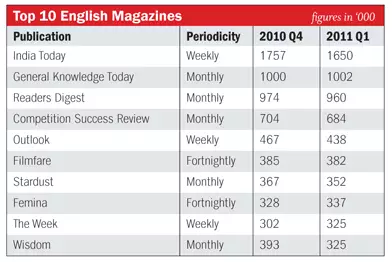
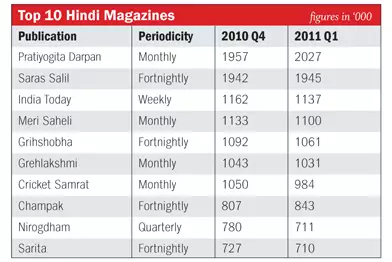
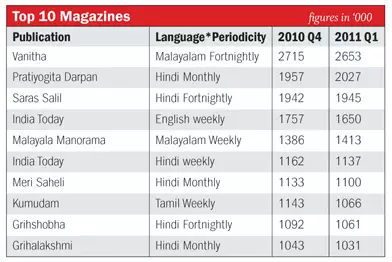
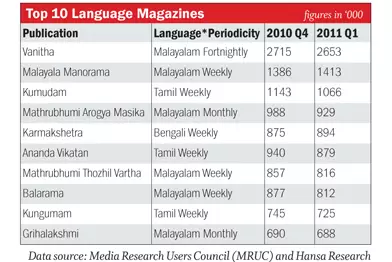
For publishers, advertising continues to generate over three quarters of total revenues, with just over a quarter coming from subscription. According to a Reuters report, for the first time in three years publishers have seen an overall increase in advertising revenues. Despite lower readership figures than regional-language titles, English-language titles take a disproportionate share of total ad revenues.
Media agency Zenith Optimedia estimates that ad spends will increase to Rs 710 cr ($160 million) in 2012 from Rs 657 cr ($143 million) during the current year.
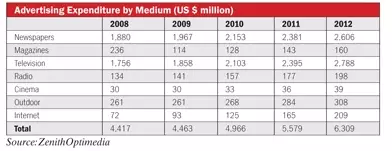
This is driven by a combination of factors. Increasing literacy and levels of affluence will drive readership levels, new entrants, including from overseas, will launch new titles in both the consumer and business-to-business sectors as well as value-added supplements from newspapers seeking to gain a competitive edge.
Alternative revenue streams, such as from events and digital platforms, will also grow. A report by consultants Ernst & Young is also optimistic, noting that a favourable regulatory policy will attract international players. A fragmented distribution system, however, highlighted by major publishers, remains an issue for the sector, although it will be partially offset by the growth of digital platforms.
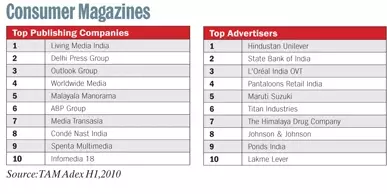
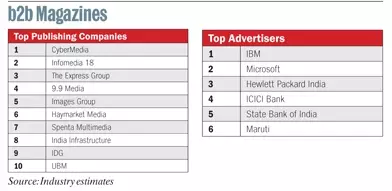
Some sixty new magazine titles were launched in 2009 and by the end of 2010 the Indian market steadied at 53,000 magazine titles.
Nevertheless, in 2010 eight out of top ten magazines saw a decline in their readership numbers. The only exceptions to the list were Pratiyogita Darpan and Malayala Manorama.
According to IRS Q1 2011, the Malayalam fortnightly Vanitha was ranked in first place with a reach of 26.53 lakh. The Hindi monthly Pratiyogita came in second position with 20.27 lakhs.
For publishers, advertising continues to generate over three quarters of total revenues, with just over a quarter coming from subscription. According to a Reuters report, for the first time in three years publishers have seen an overall increase in advertising revenues. Despite lower readership figures than regional-language titles, English-language titles take a disproportionate share of total ad revenues.
Media agency Zenith Optimedia estimates that ad spends will increase to Rs 710 cr ($160 million) in 2012 from Rs 657 cr ($143 million) during the current year.
This is driven by a combination of factors. Increasing literacy and levels of affluence will drive readership levels, new entrants, including from overseas, will launch new titles in both the consumer and business-to-business sectors as well as value-added supplements from newspapers seeking to gain a competitive edge. Alternative revenue streams, such as from events and digital platforms, will also grow.
A report by consultants Ernst & Young is also optimistic, noting that a favourable regulatory policy will attract international players. A fragmented distribution system, however, highlighted by major publishers, remains an issue for the sector, although it will be partially offset by the growth of digital platforms.


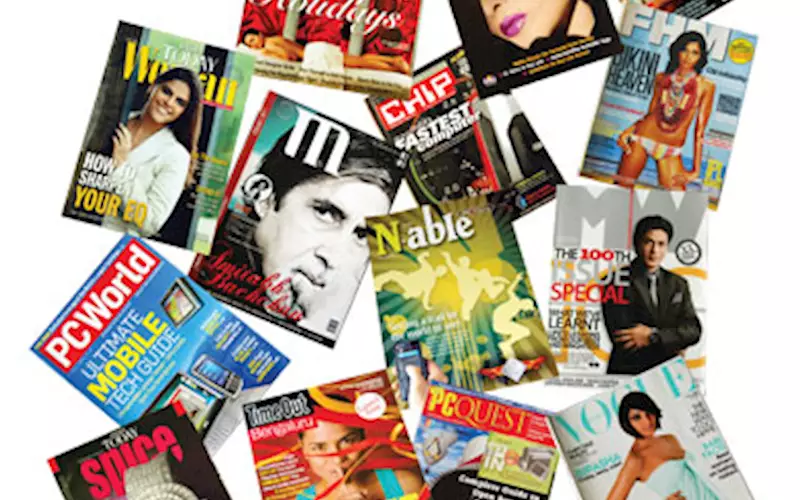








 See All
See All